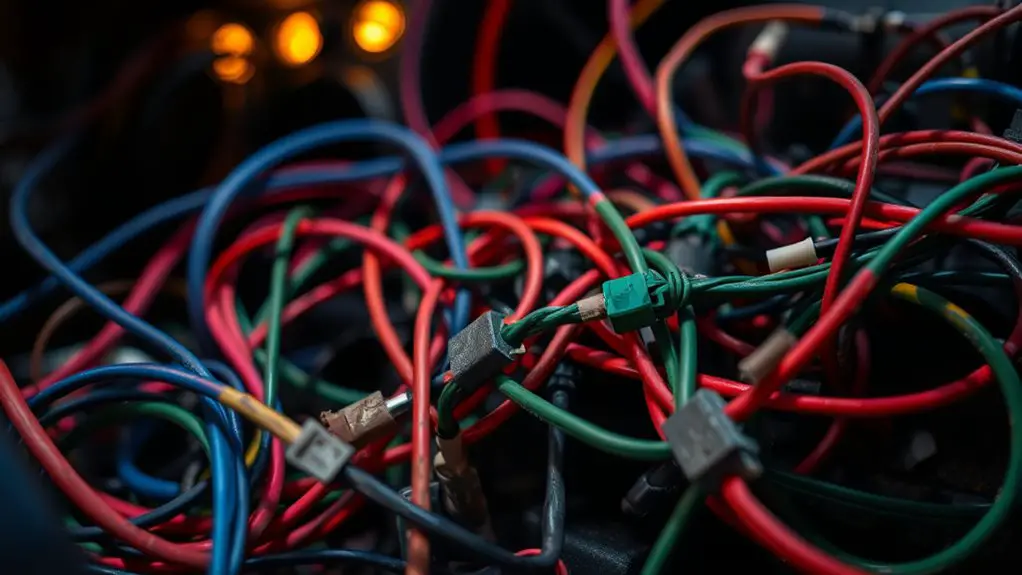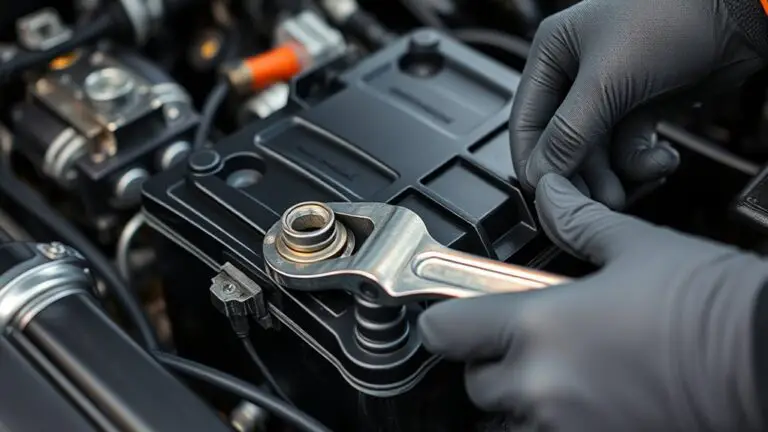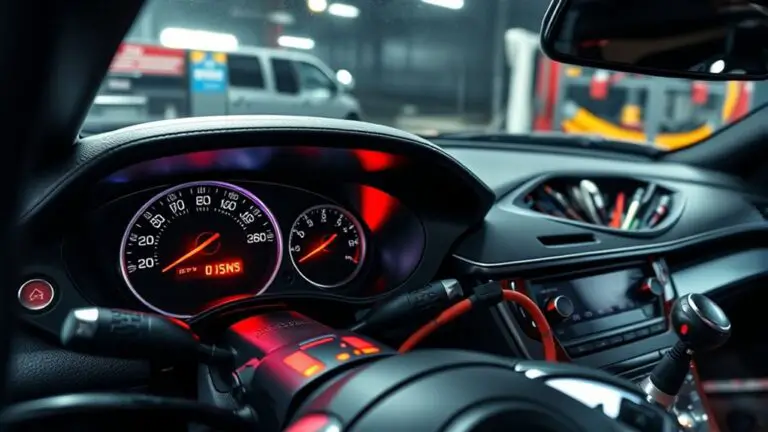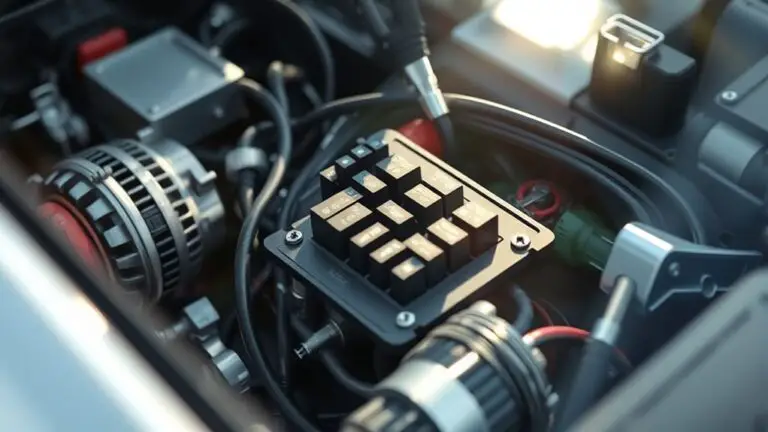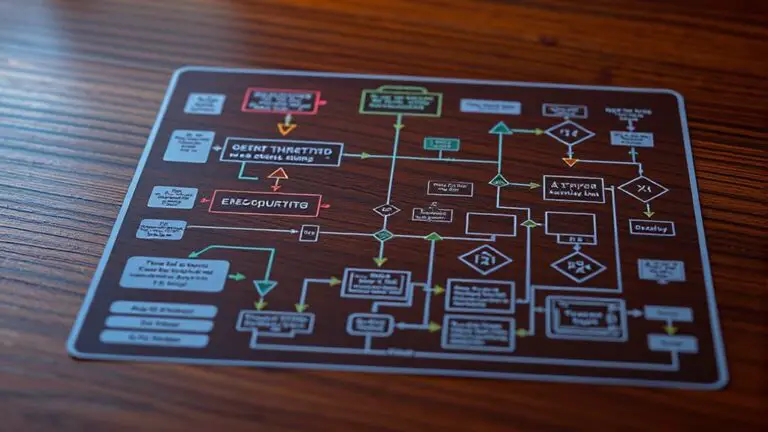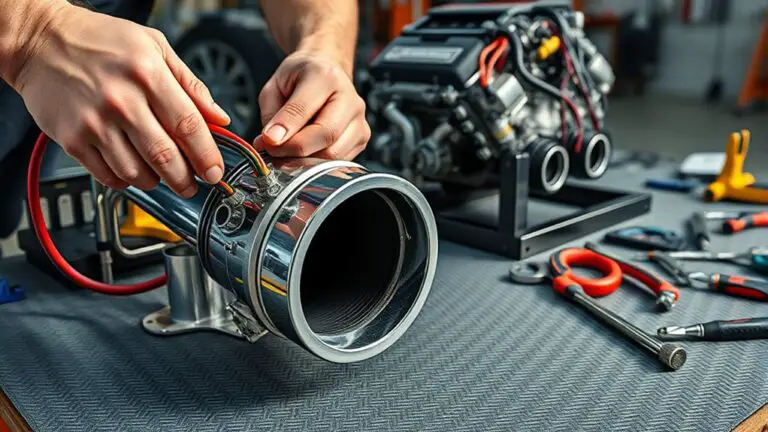Common Wiring Issues That Mimic Flickering Dashboard Lights
Flickering dashboard lights often signal common wiring issues like frayed wires, loose connections, and corroded connectors. Frayed wires can cause intermittent failures, while loose connections disrupt electrical flow. Additionally, poor ground points can lead to voltage fluctuations affecting performance. Electrical overloads and short circuits can also mimic these symptoms, indicating serious concerns that require attention. Understanding these wiring problems is essential for safety; further insights on diagnosing and resolving these issues follow.
Understanding Dashboard Light Functions
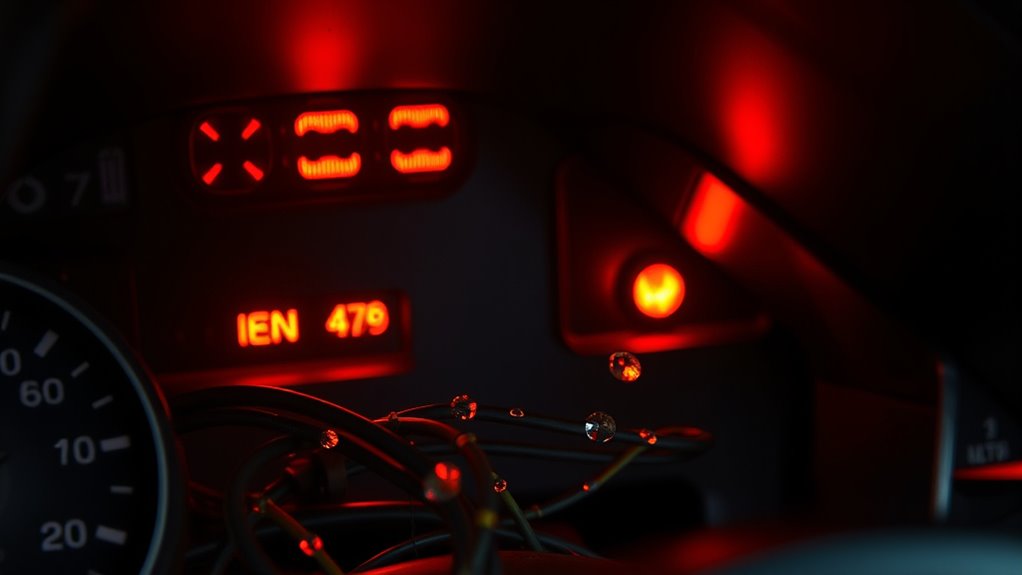
When you start your vehicle, dashboard lights illuminate to convey critical information about your car’s systems. Understanding the various dashboard light types is essential for maintaining your vehicle’s health. These lights can be categorized into warning lights, indicator lights, and informational lights.
Warning light meanings vary greatly; for example, a red battery light signals an issue with your charging system, while a yellow check engine light suggests a malfunction that requires attention. Recognizing these signals empowers you to take timely action, preventing more severe issues down the line.
Indicator lights, like turn signal indicators, serve to inform you of active functions, ensuring you’re in control. Informational lights provide updates on systems such as fuel level or tire pressure. By comprehending these dashboard signals, you enhance your driving experience, allowing for greater freedom and safety on the road. Always stay vigilant; your dashboard is your vehicle’s voice.
Frayed Wires: A Hidden Danger
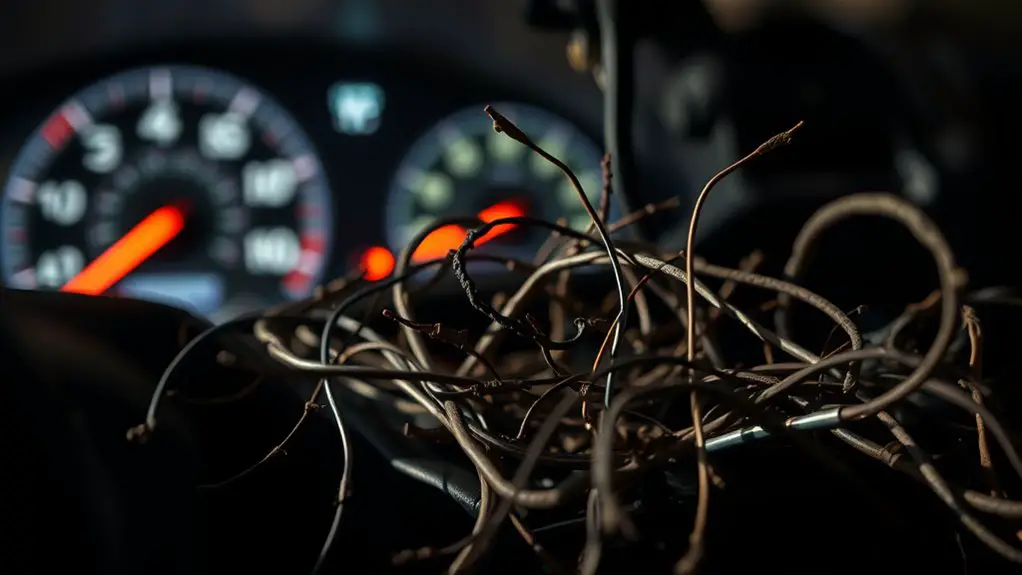
Frayed wires can pose significant hazards in your electrical systems, often resulting from wear, environmental factors, or improper installation. Recognizing the symptoms of fraying—such as exposed conductors or intermittent electrical issues—is essential for safety. In this section, you’ll learn about the causes, warning signs, and effective repair and prevention strategies to mitigate this hidden danger.
Causes of Frayed Wires
Although they may seem harmless, frayed wires often signal deeper issues that can jeopardize electrical safety. Understanding the causes of frayed wires is essential for preventing potential hazards. Here are four common contributors:
- Wire Fatigue: Repeated bending or movement causes stress, leading to fraying.
- Environmental Exposure: Extreme temperatures or moisture can deteriorate insulation, exposing wires.
- Improper Installation: Poorly secured wires can rub against surfaces, causing wear and fraying.
- Chemical Damage: Exposure to harsh chemicals can corrode insulation, leading to frayed wires.
Addressing these issues early on helps maintain electrical integrity and safety, ensuring your freedom on the road isn’t compromised by hidden dangers lurking beneath the surface. Stay vigilant for signs of frayed insulation to protect your vehicle.
Symptoms to Watch For
Identifying symptoms of frayed wires can prevent serious electrical failures. You might notice flickering lights on your dashboard, which can indicate underlying wiring issues. Keep an eye out for these specific symptoms:
| Symptoms | Possible Causes | Action Needed |
|---|---|---|
| Flickering dashboard lights | Frayed or damaged wiring | Inspect wiring connections |
| Intermittent electrical failures | Loose connections | Check for wire integrity |
| Sudden electrical surges | Short circuits | Evaluate wiring insulation |
| Unusual smells or sparks | Overheating wires | Seek professional assistance |
Dashboard diagnostics may reveal faults, but addressing frayed wiring early on can save you from costly repairs. Stay proactive and guarantee your vehicle’s electrical system remains safe and functional.
Repair and Prevention Tips
When dealing with frayed wires, addressing the issue promptly can considerably reduce the risk of electrical failures and guarantee vehicle safety. Implementing effective wiring maintenance can prevent future hazards. Here are four essential tips to take into account:
- Inspect Regularly: Check wiring for signs of wear at least once a month.
- Use Protective Sleeving: Shield vulnerable wires with heat-resistant insulation.
- Secure Connections: Verify all terminals are tight and corrosion-free.
- Replace Damaged Wires: Don’t hesitate to replace frayed wires to maintain electrical safety.
Loose Connections: The Culprit Behind Flickering
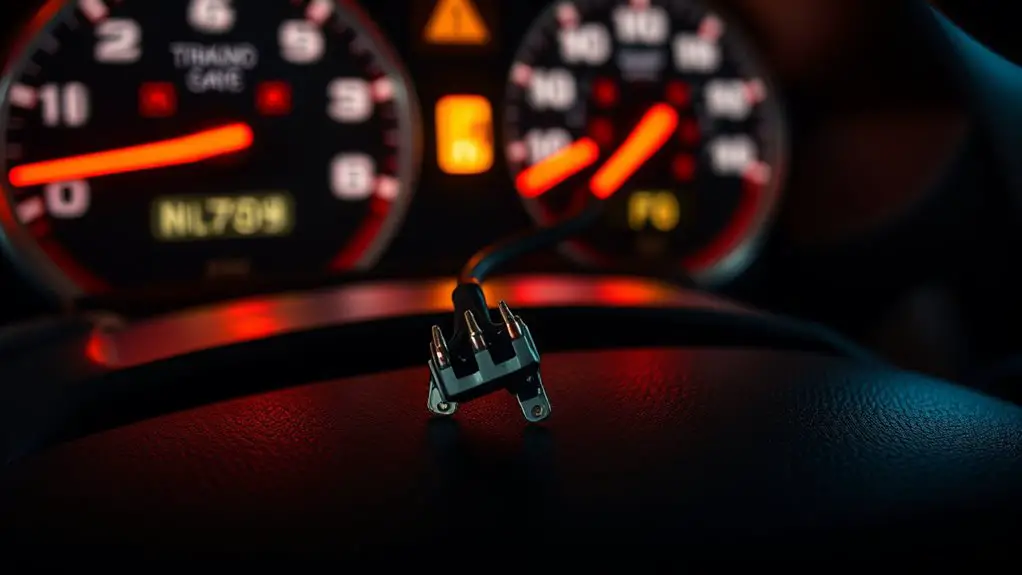
Loose connections can often be the primary cause of flickering lights in your home. When wires aren’t securely connected, they can create intermittent electrical contact, leading to erratic light behavior. This instability can be particularly problematic in older homes where wiring upgrades may not have been performed. Regular connection maintenance is essential; without it, even minor vibrations can exacerbate loose connections, resulting in flickering that disrupts your environment.
Identifying these loose connections requires careful inspection of junction boxes, switches, and outlets. Using a multimeter can help detect inconsistencies in voltage that may point to poor connections. If you find loose wires, it’s important to tighten them properly, ensuring a solid connection. If the issue persists, consider consulting a professional for a thorough assessment and potential wiring upgrades. Addressing loose connections not only enhances your lighting experience but also contributes to the overall safety and efficiency of your electrical system.
Faulty Ground Points: Why They Matter
In electrical systems, a solid ground connection is essential for safety and performance. Without it, you may experience symptoms like voltage fluctuations, equipment malfunctions, or even electrical shocks. Understanding the importance of proper ground points can help you identify and address these potentially hazardous issues.
Ground Connection Importance
Although a reliable ground connection might seem like a minor detail, faulty ground points can lead to significant electrical issues and safety hazards. Understanding the importance of a solid ground connection is crucial for maintaining your vehicle’s electrical system. Proper grounding techniques guarantee that your ground wire is securely attached, preventing erratic behavior in dashboard lights.
Consider these critical aspects of ground connections:
- Corrosion – Deterioration of metal contacts can weaken connections.
- Loose Connections – A poor fit leads to intermittent grounding.
- Insufficient Grounding – Inadequate ground paths can cause voltage drops.
- Ground Loops – Multiple ground paths can create noise and interference.
Addressing these factors is essential for peak performance and safety in your vehicle’s electrical system.
Symptoms of Poor Ground
When ground connections fail, you’ll often notice a range of symptoms that can compromise your vehicle’s electrical system. A poor ground path increases electrical resistance, leading to erratic behavior in lights and gauges. Here are some common symptoms you might encounter:
| Symptom | Description |
|---|---|
| Flickering Dashboard Lights | Intermittent power due to weak ground. |
| Dim Headlights | Insufficient current flow affecting brightness. |
| Electrical Accessories Malfunction | Inconsistent operation of devices like radio or windows. |
| Warning Lights Activation | False alerts triggered by fluctuating ground signals. |
| Engine Performance Issues | Poor ground affecting ECU communications. |
Recognizing these symptoms early can save you from more severe electrical problems down the line.
Corroded Connectors: A Common Issue
Corroded connectors can greatly hinder electrical performance, often leading to malfunctions in various systems. When you encounter flickering dashboard lights, it might be due to decreased electrical conductivity caused by corrosion. Here are some signs to watch for:
Corroded connectors can disrupt electrical performance, leading to issues like flickering dashboard lights and system malfunctions. Stay alert for signs of corrosion.
- Discoloration: Look for green or white residue around connectors.
- Loose Connections: If connectors don’t seem to fit snugly, corrosion may be the culprit.
- Intermittent Failures: Systems that work sporadically could be affected by corroded connectors.
- Increased Resistance: A rise in resistance can lead to overheating and further damage.
Addressing corroded connectors is essential for maintaining peak electrical performance. Cleaning or replacing affected connectors can restore proper electrical conductivity, ensuring your systems function as intended. By staying vigilant, you can prevent further complications and keep your vehicle’s electrical systems operating smoothly.
Short Circuits: Identifying the Problem
After addressing corroded connectors, another common issue that can disrupt electrical systems is the occurrence of short circuits. These faults happen when electrical currents bypass their intended path, often leading to flickering dashboard lights. Common short circuit causes include damaged insulation, frayed wires, or loose connections that touch metal surfaces.
To effectively diagnose shorts, start by inspecting wiring harnesses and connectors for any visible damage. Use a multimeter to check continuity; a reading of zero indicates a short. Pay attention to any unusual heat in wires or components, as this can signal a malfunction.
Lastly, consider circuit diagrams to trace potential problem areas. Identifying short circuits promptly is essential, as they can escalate into more severe electrical issues. By understanding these causes and methods for diagnosing shorts, you can maintain your vehicle’s electrical integrity and avoid further complications.
Electrical Overload: When Too Much Is Too Much
How can you tell if your electrical system is experiencing an overload? Recognizing the signs early can save you from serious issues down the line. When your circuit capacity is exceeded, various symptoms can arise, indicating a need for overload prevention. Here are four key indicators:
Recognizing the signs of electrical overload early can prevent serious issues and ensure your system runs smoothly.
- Flickering dashboard lights – A clear sign your system’s struggling under excess load.
- Frequent blown fuses – If you’re replacing fuses often, your circuits might be overwhelmed.
- Burning smell – This is a serious warning that wires are overheating due to overload.
- Tripped breakers – Safety features kicking in to prevent damage indicate your circuit’s at its limit.
Battery Issues: The Power Source
While your electrical system may be functioning well, battery issues can arise unexpectedly, impacting your overall performance. Regular battery maintenance is essential for guaranteeing reliable power delivery. If you notice flickering dashboard lights, it might be time for power testing to confirm the battery’s condition.
Here’s a table to highlight key aspects of battery maintenance:
| Maintenance Task | Frequency | Importance |
|---|---|---|
| Clean battery terminals | Every 6 months | Prevent corrosion |
| Check fluid levels | Monthly | Guarantee peak function |
| Test battery voltage | Every 3 months | Confirm power output |
| Inspect for leaks | Monthly | Avoid damage |
| Replace battery (if needed) | Every 3-5 years | Maintain reliability |
Diagnosing Wiring Problems: Steps to Take
What steps can you take to effectively diagnose wiring problems? Understanding the intricacies of your vehicle’s electrical system can empower you to pinpoint issues. Follow these steps:
- Consult Wiring Diagrams: Use the wiring diagrams specific to your vehicle model to identify connections and potential failure points.
- Visual Inspection: Examine the wiring harnesses for frayed wires, corrosion, or loose connections. Pay special attention to areas subject to movement or heat.
- Test Continuity: Employ a multimeter to test for continuity in suspect wires. If there’s no continuity, this indicates a break or short.
- Apply Troubleshooting Techniques: Isolate circuits by disconnecting components one by one, identifying which circuit affects the flickering lights.
Frequently Asked Questions
How Can I Prevent Dashboard Light Flickering in the Future?
To prevent dashboard light flickering in the future, you should prioritize regular dashboard maintenance tips and conduct thorough electrical system checks. Confirm all connections are secure and free from corrosion. Replace any worn-out components and inspect your battery for proper voltage. Keeping your vehicle’s wiring in good condition will enhance reliability. Regularly scheduled maintenance can help you catch issues early, providing you with the freedom to drive without unexpected distractions.
Can Dashboard Light Flickering Indicate a More Serious Problem?
Can dashboard light flickering indicate a more serious problem? Absolutely! When you notice dashboard signal anomalies, it’s a warning sign your vehicle’s electrical system might be failing. Ignoring these flickers could lead to bigger issues down the road, affecting not just your dashboard but the entire system. Staying proactive guarantees your freedom on the road isn’t compromised. So, don’t dismiss those lights; they could be your vehicle’s way of asking for help.
What Tools Do I Need to Diagnose Wiring Issues?
To diagnose wiring issues, you’ll need a multimeter for voltage and continuity testing, and wiring diagrams specific to your vehicle. The multimeter helps you identify faulty connections or shorts, while wiring diagrams give you a roadmap of the electrical system. By combining these tools, you can pinpoint problems accurately, ensuring you maintain both safety and functionality in your vehicle’s electrical system. This way, you’ll regain the freedom to drive without worry.
Are There Any DIY Fixes for Flickering Dashboard Lights?
You can tackle flickering lights by checking and tightening wiring connections first. Loose or corroded connections often cause intermittent power, leading to those annoying flickers. If you feel comfortable, inspect the wiring harness for any damage or wear, and replace any faulty components. Additionally, consider cleaning the contacts with electrical cleaner to guarantee a solid connection. Remember, if you’re uncertain, it’s best to consult a professional for safety.
When Should I Seek Professional Help for Dashboard Light Issues?
You should seek professional help for dashboard light issues when your troubleshooting efforts yield no results, when warning lights persist despite checks, or when you notice unusual behavior like flickering. A professional mechanic evaluation can uncover underlying problems that you might miss. Don’t ignore the signs; timely intervention can prevent costly repairs down the road. Trust your instincts—if it feels off, it’s worth having a professional take a look.

